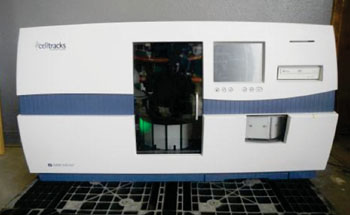Circulating Tumor Cells Indicate Poor Prognosis in Early Breast Cancer
By LabMedica International staff writers
Posted on 02 Jun 2014
Circulating tumor cells (CTCs) can predict survival in early average-to-high risk breast cancer patients and it may be possible to identify tumor cells in a routine blood sample and use them as prognostic markers. Posted on 02 Jun 2014
The detection of CTCs before the start of a new treatment has been associated with poor prognosis, the enumeration of CTCs shortly after the initiation of therapy provides additional information regarding treatment response.

Image: The CellTracks Analyzer II used for identification and enumeration of circulating tumor cells (Photo courtesy of CellSearch).
Scientists at the Ludwig Maximilians-University Munich (Germany) working with colleagues from other institutes analyzed CTCs in 2,026 patients with early breast cancer before adjuvant chemotherapy and in 1,492 patients after chemotherapy. After immunomagnetic enrichment for cells expressing the epithelial-cell adhesion molecule, CTCs were defined as nucleated cells expressing cytokeratin and lacking Protein tyrosine phosphatase, receptor type, C (CD45). The patients were followed for a median of 35 months.
CTCs were analyzed using the CellSearch System (Veridex; Raritan, NJ, USA). The identification and enumeration of CTCs were performed using the CellTracks Analyzer II (Janssen Diagnostics, Raritan, NJ, USA). CTCs were defined as nucleated cells lacking CD45 and expressing cytokeratin. The blood from 84 individuals with no clinical evidence of malignant disease was processed blinded and used as a negative control.
Patients with positive CTCs both before and after treatment had the worst disease-free survival compared to the other three groups. Overall, the probability of being disease-free at 36 months after surgery was lower for patients with CTCs than for patients without, and of those patients who died during follow-up, 40.9% had CTCs in their blood compared to 20.8% of patients who survived. In addition, the greater the CTC count, the worse the prognosis. Patients with five or more CTCs in 30 mL of blood were at higher risk of recurrent disease.
Brigitte Rack, MD, the senior author of the study, said, “Our data offer support for the clinical potential of CTCs to assess the individual risk of patients at the time of primary diagnosis and may be used for treatment tailoring in the absence of other strong quantitative markers.” The authors noted that although they used only two markers to detect CTCs, the identification of other markers could make CTCs even more useful in predicting metastases and guiding therapeutic choices. The study was published on May 15, 2014, in the Journal of the National Cancer Institute.
Related Links:
Ludwig Maximilians-University Munich
Veridex
Janssen Diagnostics














